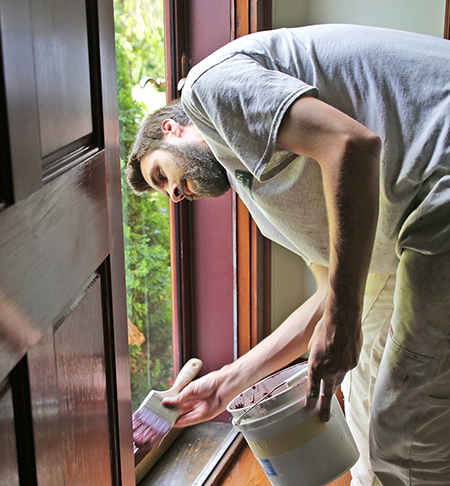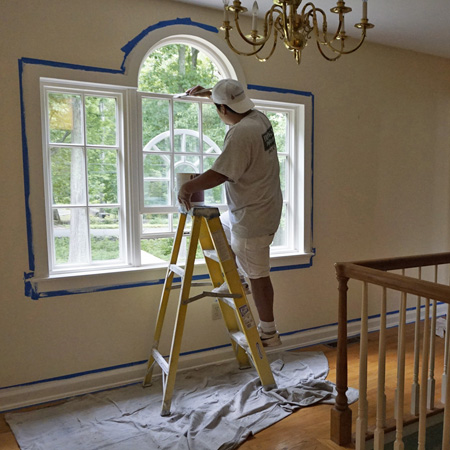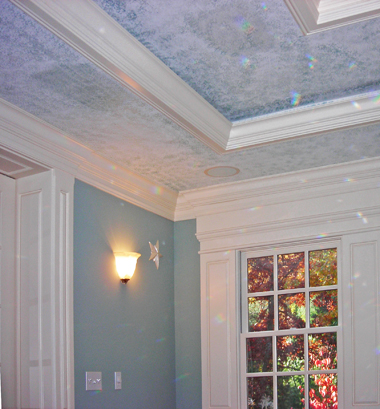An interior painting project can give your home a much-needed update. After all, there an exciting array of color choices, like Classic Blue, the Pantone® 2020 Color of the Year, that will give your home the look and feel you desire. However, a successful indoor painting project requires attention to detail and safety.
Before opening a can of paint, consider the following safety precautions:
Open Windows for Ventilation
 First and foremost, make sure the room is well ventilated when painting indoors. Breathing in paint fumes can make you seriously ill and even cause you to pass out. Open the windows so that you have cross ventilation. It will help ensure a steady supply of oxygen in the room while allowing the vapors to escape. It will also help the paint to dry faster. Mounting a box fan in the window is another safety precaution that will help remove the harmful vapors in the room.
First and foremost, make sure the room is well ventilated when painting indoors. Breathing in paint fumes can make you seriously ill and even cause you to pass out. Open the windows so that you have cross ventilation. It will help ensure a steady supply of oxygen in the room while allowing the vapors to escape. It will also help the paint to dry faster. Mounting a box fan in the window is another safety precaution that will help remove the harmful vapors in the room.
Use Low-VOC or No-VOC Paint
Many oil-based paints contain volatile organic compounds (VOC) that can harm your health and the environment. The chemicals are released into the air as the paint dries. Exposure to these vapors can cause headaches, nausea, and dizziness. Paint manufacturers have significantly improved the quality and durability of low-VOC and no-VOC paints. They contain more natural additives for pigmentation instead of relying solely on petrochemicals. To reduce exposure to toxic fumes, use low- or no-VOC paint for indoor painting projects.
Wear Protective Clothing
Wearing personal protective equipment (PPE) when painting is a prudent safety precaution. It will protect your skin, eyes, nose, and lungs from coming into contact with the paint and any harmful vapors. Your PPE painting gear should include an anti-dust mask, gloves, goggles or glasses, and a smock or long-sleeve shirt.
Use Ladders with Care
 There are more than 500,000 ladder injuries each year, according to the American Academy of Orthopedic Surgeons. Over 97% of ladder falls occur in the home. Using the right ladder and height is an essential safety step when painting at home. The feet of the ladder should be securely planted on the ground. Also, the Occupational Health and Safety Administration (OSHA) recommends maintaining the 3-point position when climbing the ladder.
There are more than 500,000 ladder injuries each year, according to the American Academy of Orthopedic Surgeons. Over 97% of ladder falls occur in the home. Using the right ladder and height is an essential safety step when painting at home. The feet of the ladder should be securely planted on the ground. Also, the Occupational Health and Safety Administration (OSHA) recommends maintaining the 3-point position when climbing the ladder.
This means that either two-hands and one foot or two feet and one hand should be on the ladder when climbing. Also, don’t exceed the rated load weight for the ladder.
Allow Ample Time for Paint to Dry
It will not be safe to occupy the room immediately after painting. Depending on the type of paint and size of the room, it can take one to three days for the paint to dry and any harmful vapors to escape. Also, keep the window open for ventilation and facilitate the drying process. Keep children and small pets away from the space until the paint is completely dry.
For Best Results, Hire a Pro
Painting may seem like a fun DIY project, but there is plenty of work involved. You must select the right paint, take safety precautions, and have the professional tools and equipment for the job. Hiring an experienced professional painter saves time and can give you impressive results with minimal effort on your part. Many painters warranty their work to help ensure customer satisfaction.

Frank Campanelli, the esteemed founder of Franklin Painting LLC, has been leading the company since 1986. He takes immense pride in the stellar reputation his dedicated team has built by consistently delivering top-notch service to each customer.



